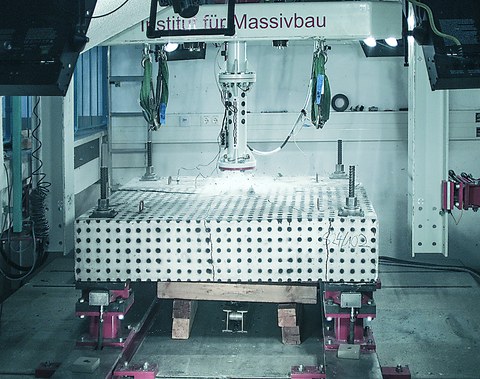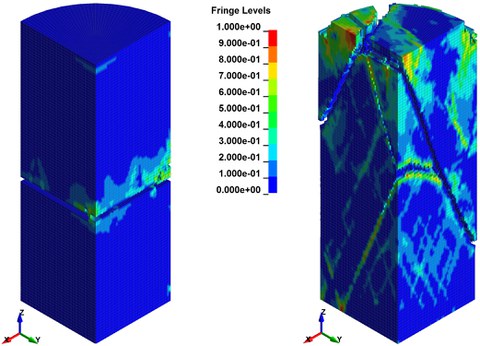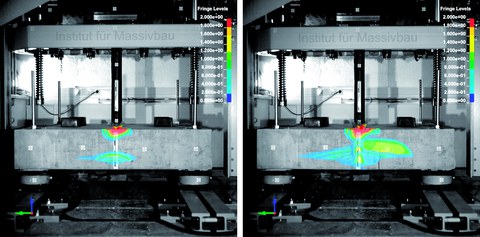RC slabs under impact loading
Table of contents
Project data
| Titel | Title Experimentelle Untersuchung des Verhaltens von Stahlbetonplatten unter Impaktbelastung | Experimental study of reinforced concrete slabs under impact loading Förderer | Funding Deutsche Forschungsgemeinschaft (DFG) / Bundle proposal Zeitraum | Period 07/2013 − 06/2016 Leiter | Project manager Prof. Dr.-Ing. Dr.-Ing. E.h. Manfred Curbach Bearbeiter | Contributor Tino Kühn M.Sc. Projektpartner | Project partners Institut für Statik und Dynamik der Tragwerke, TU Dresden | Fraunhofer-Institut für Kurzzeitdynamik Ernst-Mach-Institut (EMI), Freiburg |
Report in the year book 2016
Drop tests up to 150 m/s

Sequence of frames of a projectile impact
Besides quasi-static and dynamic loads, impact loads can play a decisive role in the structural design of buildings. This mainly concerns infrastructure of ‘particular importance’ or of ‘vital importance’ to society. Accordingly, a comprehensive understanding of the damage and the load bearing behaviour of structures under impact loads is a pre-requisite for their assessment. Implementation of a short-term dynamic analysis also requires knowledge related to the impact phenomena, such as strain-dependent material behaviour and stress distribution within a structure.
In the free-fall configuration of the drop test facility in the Otto-Mohr-Laboratory of the TU Dresden, large samples with different impactors and drop masses in the range of 500 to 2,500 kg falling from a height of up to 10 m can be experimentally tested. The velocities resulting from the drop heights are in the range from 0–14 m/s. The impactors are flexibly adaptable to the respective load types and can represent various scenarios in the experiment. The supporting foundation is a pre-tensioned four-point bearing bed, which includes a damper for absorbing excessive energy, and it is equipped to measure corresponding bearing forces.
With this configuration, about 20 different slab tests were carried out within a project in order to investigate the speed dependence of the resulting damage. In addition, experiments have been running at higher speeds since 2016. For this purpose, a compressed-air acceleration device was integrated into the system. With a maximum storage energy of approx. 120 kJ, it allows projectiles with a mass of approx. 5–100 kg to accelerate to speeds in the range of approx. 10–150 m/s. impactor can optionally be guided directly onto the surface of the sample. The guidance of the projectiles right up to the sample is done for safety reasons, and it is useful for conducting experiments in which the test specimen is not punched through. If a breakthrough is desired, the projectiles are safely intercepted and attenuated below the sample.
Report in the year book 2015
Understanding concrete failure numerically using FEM

Spatial strain distribution within a tensile (left) and compressive (right) loaded cylindrical steel fibre sample ad time of global maximum stress
The experimental and numerical study of the behaviour of structures under dynamic and static loading conditions is one of the main research subjects at the TU Dresden Institute of Concrete Structures. A variety of projects on this subject, regarding the local material behaviour under various loading conditions, as well as its influence on the global structural behaviour at moderate stress rates, are pending. Typical and representative load scenarios are for example impact loads due to vehicle or aircraft crashing, or those caused by falling rocks. These high speed dynamic experiments probably lead to the so called strain rate effect in the form of an increase in the strength of concrete. This theory has already been postulated by several authors, both for the pressure range as well as for the tensile domain.
Regardless, this effect can be described using numerical models as some sort of viscosity or damping at low strain rates or as a crack opening inertia at higher speeds. But based on a variety of numerical benchmark models, it could also be shown that the structural and material response in the underlying experiments cannot be separated since these characteristics are interconnected. This fact makes it extremely difficult to transfer material parameters from dynamic experimental observations into real case scenarios or into generally accepted calculation models.
Furthermore, the numerical modelling of the underlying experimental procedures sheds light on the true conditions of the experiment and shows that the preliminary assumptions that are formulated for strain rate effects are very simplified and not quite reliable. With the knowledge of the local interactions, the current evaluations methods can be critically analysed and optimized, which will be done in future.
Report in the year book 2014
Simulation of concrete under high strain rates

Experimental observed failure patterns and numerical results at different times
Concrete behaves under dynamic loads distinctly than under static loads. As essential reasons for this, internal load transfer effects at relatively low loading rates and inertial effects in the formation of cracks at higher speeds, are proposed. Other researchers assume that methodical errors in the measuring procedure of these effects and difficulties to clearly separate material and structural phenomena are an essential cause of this alleged effect.
These and similar questions can be investigated numerically on larger components. This is the reason why in this project various methods are joined to determine the characteristic dynamic material parameters, and to carry out high dynamic plate impact experiments. The numerical simulations of these reference tests intended to reflect what happens inside a concrete component, and how the stresses change inside the component in space and time due to dynamic loading. This is important, for example, in the study of impact events on structural components of any kind.
In small-scale tests in the split Hopkinson pressure bar, it has been obtained, for example, stress-strain curves, from which one can derive a relationship between strain rate and average strain to failure. The experiments show a significant increase in strength over the strain rate. It suggests a linear relationship. Also, other material parameters are dependent on the loading rate, which will be further investigated.
Besides these tests, numerical simulations are carried out, where in addition to static material assumptions, both physical effects mentioned above are taken into account.
The comprehensive comparison of the calculated and the experimental data obtained from the plate tests is being developed. However, recent comparisons indicate very good numerical correlation of the phenomena including impact and spallation.
